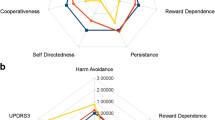Abstract
Relative vulnerability to dyskinesia in terms of exposure to antipsychotic drugs prior to onset of dyskinesia was studied in a sample of 100 psychiatric patients with dyskinesia onset generally within a year or less of the point of study entry. Unipolar and bipolar patients were more vulnerable to dyskinesia than other diagnostic groups. In the total sample, lithium exposure did not appear to delay development of dyskinesia. Longer exposure to antiparkinson drugs was associated with delayed onset of dyskinesia. Past exposure to electroconvulsive therapy was related to decreased vulnerability to dyskinesia.
Similar content being viewed by others
References
Casey DE (1984) Tardive dyskinesia and affective disorders. In: Gardos G, Casey DE (eds) Tardive dyskinesia and affective disorder. American Psychiatric Press, Washington, DC, pp 1–20
Gardos G, Cole JO (1983) Tardive dyskinesia and anticholinergic drugs. Am J Psychiatry 140:200–202
Gardos G, Cole JO, Rapkin R, LaBrie R, Bacquelod E, Moore P, Sovner R, Doyle J (1984) Anticholinergic challenge and neuroleptic withdrawal. Arch Gen Psychiatry 41:1030–1035
Gardos G, Cole JO, Haskell D, Marby DW, Paine-Schniebolk S, Moore P (1988) The natural hystory of tardive dyskinesia. J Clin Psychopharmacology 8[4] suppl:31–37
Guy W (1976) ECDEU Assessment Manual for Psychopharmacology. US Department of Health, Education and Welfare, Washington, DC, pp 534–537
Jeste DV, Wyatt RJ (1982) Understanding and treating tardive dyskinesia. Gulford Press, New York
Kane JM, Smith JM (1982) Tardive dyskinesia. Arch Gen Psychiatry 39:473–481
Kane J, Woerner M, Weinhold P et al. (1982) A prospective study of tardive dyskinesia development: preliminary results. J Clin Psychopharmacol 2:345–349
Kane JM, Woerner M, Borenstein M, Wegner J, Lieberman J (1986) Integrating incidence and prevalence of tardive dyskinesia. Psychopharmacol Bull 22:254–258
Klawans H, Weiner W, Nauseida P (1977) The effect of lithium on an animal model of tardive dyskinesia. Prog Neuropsychopharmacol 1:53–60
Mason AS, Granacher RP (1978) Clnical handbook of antipsychotic drug therapy. Brunner/Mazel, New York
Schooler NR, Kane JM (1982) Research diagnoses for tardive dyskinesia. Arch Gen Psychiatry 39:486–487
Simpson G, Varga E, Lee H, Zoubok B (1978) Tardive dyskinesia and psychotropic drug history. Psychopharmacology 58:117–124
Toenniessen L, Casey D, McFarland B (1985) Tardive dyskinesia in the aged: duration of treatment relationships. Arch Gen Psychiatry 42:278–284
Yassa R, Ghadrian A, Schwartz G (1983) Prevalence of tardive dyskinesia in affective disorder patients. J Clin Psychiatry 44:410–412
Author information
Authors and Affiliations
Additional information
This work was supported in part by Grant #MH-32675-11 from the National Institute of Mental Health.
Rights and permissions
About this article
Cite this article
Cole, J.O., Gardos, G., Boling, L.A. et al. Early dyskinesia — vulnerability. Psychopharmacology 107, 503–510 (1992). https://doi.org/10.1007/BF02245263
Received:
Revised:
Issue Date:
DOI: https://doi.org/10.1007/BF02245263




